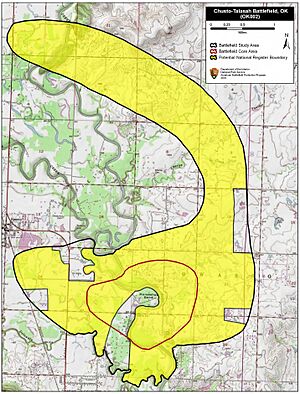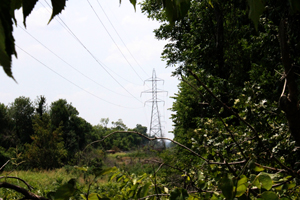Battle of Chusto-Talasah facts for kids
Quick facts for kids Battle of Chusto-Talasah |
|||||||
|---|---|---|---|---|---|---|---|
| Part of the Trans-Mississippi Theater of the American Civil War |
|||||||
 The Chusto-Talasah battlefield as it exists today. Photo taken July 2011 by Jeffrey S. Williams |
|||||||
|
|||||||
| Belligerents | |||||||
| Creek Seminole |
Cherokee Choctaw |
||||||
| Commanders and leaders | |||||||
| Opothleyahola | Douglas H. Cooper | ||||||
| Strength | |||||||
| 2,000–2,500 men | 1,300 men | ||||||
| Casualties and losses | |||||||
| 9 killed 500 total |
15–30 killed 37 wounded ~400 deserted |
||||||
The Battle of Chusto-Talasah, also known as Bird Creek, Caving Banks, or High Shoal, was a fight during the American Civil War. It happened on December 9, 1861, in what is now Tulsa County, Oklahoma. Back then, this area was known as Indian Territory.
This battle was the second of three important fights in a series called the Trail of Blood on Ice campaign. These battles were all about who would control Indian Territory during the Civil War.
Contents
Why the Battle Happened
Native American Groups in the Civil War
During the Civil War, some Native American groups supported the Union (the North), and others sided with the Confederacy (the South). This battle involved both sides.
- The Union side included the Creek and Seminole people. They were led by a brave Creek chief named Opothleyahola.
- The Confederate side included soldiers from the Confederacy, along with Cherokee and Choctaw warriors. Their leader was Col. Douglas H. Cooper.
The Trail of Blood on Ice Campaign
Chief Opothleyahola and his Union-supporting forces had just lost a battle at Round Mountain. After that defeat, they started moving northeast, hoping to find a safer place.
The Battle at Bird Creek
Confederate Attack
On December 9, 1861, Chief Opothleyahola's group was at a place called Chusto-Talasah. This spot was also known as Caving Banks, located on a curve of Bird Creek. Around 2:00 p.m., Colonel Cooper and his 1,300 Confederate soldiers attacked.
Chief Opothleyahola knew Cooper was coming. He had placed his troops in a strong defensive spot within thick woods at Horseshoe Bend.
Fighting and Retreat
The battle lasted for almost four hours. Colonel Cooper's forces attacked repeatedly, trying to get around the Union-supporting Native American fighters. Just before dark, the Confederates finally pushed Opothleyahola's forces across Bird Creek.
Colonel Cooper's troops stayed there overnight. They didn't chase Opothleyahola's group because they were running low on ammunition.
Who Won?
The Confederates said they won the battle. However, some stories suggest that Opothleyahola's forces actually managed to push back their attackers. No matter who won this specific fight, Chief Opothleyahola and his group kept moving, looking for a safer place.
The Union-supporting Native American forces had many casualties. Colonel Cooper estimated their losses at about 500 people. The Confederates had fewer losses, with 15 killed and 37 wounded.
What Happened Next
Even if the Confederates only won a small victory at Chusto-Talasah, they would go on to win a much bigger battle later that month. That next major fight was the Battle of Chustenahlah.
Battle Site Today
The Chusto-Talasah battle site is on private land. It's located near 86th Street North and Delaware Avenue, about 5 miles northwest of modern Tulsa. A granite marker in Sperry, Oklahoma also points to the battle site, saying it's 9 miles northeast-southeast from there.
Who Fought in the Battle
Confederate Forces
The Confederate side was led by Colonel Douglas H. Cooper. His forces included:
- Soldiers from the 1st Choctaw-Chickasaw Mounted Rifles
- Parts of the Choctaw Battalion
- Parts of the 1st Creek Regiment
- Other Creek warriors
- The 1st Cherokee Mounted Rifle Regiment
- The 4th Texas Cavalry Regiment
- Parts of the 9th Texas Cavalry
- Whitfield’s Battalion
Union-Supporting Native American Forces
Chief Opothleyahola led the Native American groups who supported the Union. These included:
- Lockapoka Creeks
- Muscogee Creeks
- Seminoles, led by Halleck Tustenuggee and Sonuk Mikko



